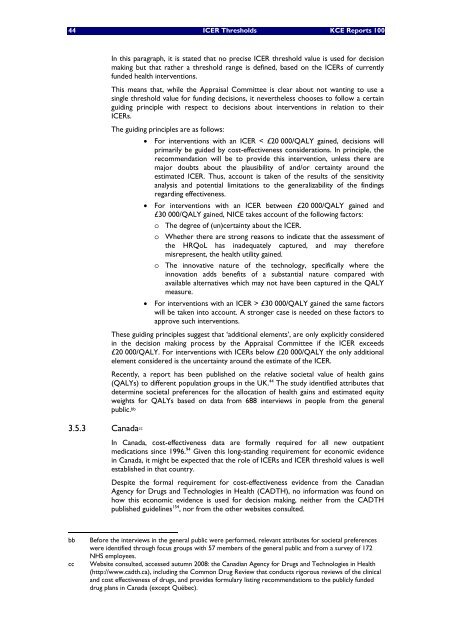Valeurs seuils pour le rapport coût-efficacité en soins de santé - KCE
Valeurs seuils pour le rapport coût-efficacité en soins de santé - KCE
Valeurs seuils pour le rapport coût-efficacité en soins de santé - KCE
Create successful ePaper yourself
Turn your PDF publications into a flip-book with our unique Google optimized e-Paper software.
44 ICER Thresholds <strong>KCE</strong> Reports 100<br />
3.5.3 Canada cc<br />
In this paragraph, it is stated that no precise ICER threshold value is used for <strong>de</strong>cision<br />
making but that rather a threshold range is <strong>de</strong>fined, based on the ICERs of curr<strong>en</strong>tly<br />
fun<strong>de</strong>d health interv<strong>en</strong>tions.<br />
This means that, whi<strong>le</strong> the Appraisal Committee is c<strong>le</strong>ar about not wanting to use a<br />
sing<strong>le</strong> threshold value for funding <strong>de</strong>cisions, it neverthe<strong>le</strong>ss chooses to follow a certain<br />
guiding princip<strong>le</strong> with respect to <strong>de</strong>cisions about interv<strong>en</strong>tions in relation to their<br />
ICERs.<br />
The guiding princip<strong>le</strong>s are as follows:<br />
• For interv<strong>en</strong>tions with an ICER < £20 000/QALY gained, <strong>de</strong>cisions will<br />
primarily be gui<strong>de</strong>d by cost-effectiv<strong>en</strong>ess consi<strong>de</strong>rations. In princip<strong>le</strong>, the<br />
recomm<strong>en</strong>dation will be to provi<strong>de</strong> this interv<strong>en</strong>tion, un<strong>le</strong>ss there are<br />
major doubts about the plausibility of and/or certainty around the<br />
estimated ICER. Thus, account is tak<strong>en</strong> of the results of the s<strong>en</strong>sitivity<br />
analysis and pot<strong>en</strong>tial limitations to the g<strong>en</strong>eralizability of the findings<br />
regarding effectiv<strong>en</strong>ess.<br />
• For interv<strong>en</strong>tions with an ICER betwe<strong>en</strong> £20 000/QALY gained and<br />
£30 000/QALY gained, NICE takes account of the following factors:<br />
o The <strong>de</strong>gree of (un)certainty about the ICER.<br />
o Whether there are strong reasons to indicate that the assessm<strong>en</strong>t of<br />
the HRQoL has ina<strong>de</strong>quately captured, and may therefore<br />
misrepres<strong>en</strong>t, the health utility gained.<br />
o The innovative nature of the technology, specifically where the<br />
innovation adds b<strong>en</strong>efits of a substantial nature compared with<br />
availab<strong>le</strong> alternatives which may not have be<strong>en</strong> captured in the QALY<br />
measure.<br />
• For interv<strong>en</strong>tions with an ICER > £30 000/QALY gained the same factors<br />
will be tak<strong>en</strong> into account. A stronger case is nee<strong>de</strong>d on these factors to<br />
approve such interv<strong>en</strong>tions.<br />
These guiding princip<strong>le</strong>s suggest that ‘additional e<strong>le</strong>m<strong>en</strong>ts’, are only explicitly consi<strong>de</strong>red<br />
in the <strong>de</strong>cision making process by the Appraisal Committee if the ICER exceeds<br />
£20 000/QALY. For interv<strong>en</strong>tions with ICERs below £20 000/QALY the only additional<br />
e<strong>le</strong>m<strong>en</strong>t consi<strong>de</strong>red is the uncertainty around the estimate of the ICER.<br />
Rec<strong>en</strong>tly, a report has be<strong>en</strong> published on the relative societal value of health gains<br />
(QALYs) to differ<strong>en</strong>t population groups in the UK. 44 The study id<strong>en</strong>tified attributes that<br />
<strong>de</strong>termine societal prefer<strong>en</strong>ces for the allocation of health gains and estimated equity<br />
weights for QALYs based on data from 688 interviews in peop<strong>le</strong> from the g<strong>en</strong>eral<br />
public. bb<br />
In Canada, cost-effectiv<strong>en</strong>ess data are formally required for all new outpati<strong>en</strong>t<br />
medications since 1996. 94 Giv<strong>en</strong> this long-standing requirem<strong>en</strong>t for economic evid<strong>en</strong>ce<br />
in Canada, it might be expected that the ro<strong>le</strong> of ICERs and ICER threshold values is well<br />
established in that country.<br />
Despite the formal requirem<strong>en</strong>t for cost-effectiv<strong>en</strong>ess evid<strong>en</strong>ce from the Canadian<br />
Ag<strong>en</strong>cy for Drugs and Technologies in Health (CADTH), no information was found on<br />
how this economic evid<strong>en</strong>ce is used for <strong>de</strong>cision making, neither from the CADTH<br />
published gui<strong>de</strong>lines 154 , nor from the other websites consulted.<br />
bb Before the interviews in the g<strong>en</strong>eral public were performed, re<strong>le</strong>vant attributes for societal prefer<strong>en</strong>ces<br />
were id<strong>en</strong>tified through focus groups with 57 members of the g<strong>en</strong>eral public and from a survey of 172<br />
NHS employees.<br />
cc Website consulted, accessed autumn 2008: the Canadian Ag<strong>en</strong>cy for Drugs and Technologies in Health<br />
(http://www.cadth.ca), including the Common Drug Review that conducts rigorous reviews of the clinical<br />
and cost effectiv<strong>en</strong>ess of drugs, and provi<strong>de</strong>s formulary listing recomm<strong>en</strong>dations to the publicly fun<strong>de</strong>d<br />
drug plans in Canada (except Québec).

















